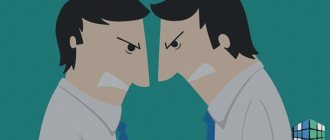People tend to experience anxiety in situations of subjective significance, for example, when applying for a job or asking a girl out on a date. Anxiety stems from internal doubts, fears, uncertainty, awareness of risks and alternative options. Situations of choice encourage anxiety. It seems to a person that his whole life depends on this choice, which causes anxiety (“what if I’m wrong”). However, people often forget that there is no right choice. There is always a choice and its consequences, which a person can or cannot cope with. So should you worry?
Causes
According to statistics, pathological fear occurs due to two most common reasons:
- Stressful or traumatic situation. This reason is the most common, although people do not always remember what exactly happened, as a result of which constant fear appeared. However, a series of associations associated with a past situation can cause fear. For example, the fear of driving is based on a previously experienced accident, and the fear of choking is based on food getting stuck, which caused a panic experience. People with a developed imagination can acquire a phobia after a terrible incident with friends, or simply after seeing something frightening on TV.
- Hereditary factor. Many fears, for example, fear of heights, snakes, spiders, etc. are based on the instinct of self-preservation and are inherent in all humanity. However, in people with a weak nervous system or a hereditary predisposition, the instinct of self-preservation can transform into obsessive fear.
Understanding and establishing the true causes of fears is already half the success towards answering the question of how to cope with phobias.
Method 2 - Practice relaxation techniques: diaphragmatic breathing
Relaxation techniques are a great way to cope with anxiety. For example, diaphragmatic breathing activates the parasympathetic nervous system, which is responsible for peace and relaxation. It also suppresses the activity of the sympathetic nervous system, which is triggered at the time of anxiety.
You can watch the technique of performing diaphragmatic breathing in my video. By the way,
It constantly releases new videos about overcoming panic attacks and anxiety.
Add a little mindfulness: when you do diaphragmatic breathing, direct all your attention to the sensations in your stomach, feel the tension as you inhale, the feeling of compression as you exhale, any sensations in the pause between inhalation and exhalation.
Try to keep your attention only on these sensations. If you notice that your mind has begun to wander, thinking about disturbing thoughts, calmly noticing this, return your attention back to the sensations when breathing. And do this for the entire time that you are doing the exercise.
Diaphragmatic breathing can be performed for 3 minutes several times a day, as well as during attacks of anxiety and fear.
Types of phobias
The most common are social phobia - fear of communication, public speaking, and agoraphobia - fear of open spaces. They are closely followed by claustrophobia - the fear of closed spaces. Less common are fears of blood, spiders, snakes, mice, water, fire, heights, corpses, funeral supplies, darkness, and various diseases. There are also very rare phobias - fear of mirrors, walking across a bridge, or being in certain rooms and on certain types of terrain or with certain types of people.
In principle, almost anything can become a phobia, but one should not go to extremes and confuse a phobia with ordinary fear. For example, every normal person is afraid of heights, but this does not mean that he has a phobia. In the same way, people have a genetic aversion to insects and arthropods. This has a completely reasonable reason - for tens of thousands of years they have been stinging, biting and infecting our ancestors, so a normal person would not rejoice at the sight of a lice or a pot-bellied spider. But we can reasonably talk about a phobia only when the sight of an ordinary house spider or mouse causes a panic attack.
The danger of the condition and the possibilities of modern therapy
Now let's talk about whether treatment for phobias is required, how necessary professional intervention is and how to get rid of phobias and fears on your own. Considering that panic states, even those that do not occur too often, negatively affect the quality of life, it is necessary to ask the question of how to cure a phobia, especially since today there are many techniques that allow you to cope with this condition. The effectiveness of therapy is high both in the case of professional intervention and in self-treatment, subject to the basic rule - there must be a willingness to analyze the underlying factors that provoked the development of fear and a sincere desire to eliminate it from one’s own life. When approaching the problem, specialists use a specific scheme on how to get rid of phobia, fear and panic states:
- The first stage is a clear definition of the phenomenon that causes fear and worsens physical condition.
- The second stage is working with the very cause of fear, while professionals at this stage use hypnosis and psychotherapy techniques. Conducting special sessions helps the patient to realize and accept his fears, and allows him not to lose constructive thinking in the event of a critical situation.
- The third stage of how to treat phobias is controlling fears in practice and the ability to make the right decisions without the desire to escape from reality.
Humanity needs anxiety
"What's brown and stick-like...?"
It is important to understand that anxiety is, firstly, natural, and secondly, the tendency to anxiety is quite common among the human population.
Since ancient times, human communities have consisted of both people prone to excessive risk taking and people with exaggerated caution and anxiety. Both were needed for everyone's survival.
“Risk guys” without much thought and reflection got involved in dangerous adventures: they went to hunt a dangerous predator alone in an unknown territory. And in many situations, these risks bore fruit: the hero returned with prey at the ready, and the tribe rejoiced in anticipation of dinner. But this did not always happen. Often our “risky” hero himself became dinner for the predator.
Therefore, our anxious ancestors, anticipating danger, balanced the excessive tendency to take risks and said: “listen, we have never been in this territory, maybe we need to be better prepared, take more people, or just hunt in familiar territory for now?”
If human tribes consisted of only “risky” and “reckless” relatives rushing into the face of uncertainty, then the end of humanity would not be long in coming. Therefore, we can say that anxiety saved our species.
At the same time, I do not want to say that anxious people were mostly “in the rear,” while only their reckless relatives exposed themselves to danger.
Many of my clients with anxiety disorders are people of dangerous professions: former military personnel, representatives of the Ministry of Emergency Situations, police officers.
The illusion of danger and the illusion of safety
Anxiety is a normal and natural evolutionary mechanism that has been around for millions of years. And at the same time, this mechanism was formed in such a way that it became sensitive to false positive stimuli.
What does it mean? This means that when our ancient ancestor, leaving his home sleepily, came across a stick lying on the ground, he could, mistaking it for a snake, jump away from it in fear. In such a situation, a person succumbed to illusion, but nevertheless remained alive and well.
But if everything happened the other way around: a poisonous snake was lying on the ground, and a person mistakes it for a stick (false negative stimulus “This is not a snake, there is nothing to be afraid of”), then he risked being stung and losing his life.
That is why our mind, since ancient times, has been structured in such a way that it is better to “over-watch”, leading us into the illusion of danger, than to “under-watch.” Because the illusion of safety can be more costly than the illusion of danger.
And due to this mechanism, we often see danger where there is none (or where its probability is extremely low) and our mind gives us the most terrible scenario of what is happening.
You made a mistake in your weekly report and are already thinking that you will be fired, although all employees make mistakes and you are in good standing with the company.
Or your heart rate quickened a little while walking up the stairs, and you thought about the risk of a heart attack.
In the modern civilized world, unlike the ancient steppes and jungles, there are not so many daily direct threats to life. Therefore, anxiety “spills over” to everyday events, many of which are “trifling” compared to the real prospect of dying in the jaws of a predator during a hunt.
And often in the modern world, anxiety does not save us or protect us from anything, but only torments us all day long.
How many times can you remember when anxiety forced you to act, recognize danger and prevent it?
It is likely that such situations existed, but the overwhelming amount of anxiety is simply the fruitless work of your imagination, alternating and thinking in circles of the same alarming scenarios, incessant “mental chewing gum.”
Chronic anxiety deprives us of peace and mental strength, plagues us day and night, and prevents us from developing and enjoying life. And now I will tell you what to do about it.
When is phobia treatment needed?
Phobias can manifest themselves in the form of various fears, for example:
- loss of consciousness;
- of death;
- committing aggression towards someone or oneself;
- various diseases;
- public, large crowds of people;
- loss of self-control;
- public transport;
- and much more.
The main sign of the presence of the disease is a decrease in quality of life. In this case, the manifestation of the phobia is clearly manifested. When negative thoughts cannot be suppressed by willpower and/or they constantly haunt a person in the form of obsession. It is necessary to treat a phobia in any of its manifestations from the moment the quality of life begins to decline.
There is no need to treat ordinary fears that every person has, since they can be suppressed by an effort of will, they can be overcome, and they do not reduce a person’s quality of life. Such fears do not qualify as phobias.
Method of working with anxiety and disturbing thoughts 4 – “Separation” Technique
And here we are again returning to the principles of mindfulness: attention management, non-judgment, acceptance. And you remember that the main habitual reactions to anxious thoughts are to either give in to them or suppress them.
But there is a third, effective scenario - do nothing with your thoughts. Don't get involved, but don't overwhelm either. Just let them come. As soon as they come, without arguing with them, without analyzing them, just notice them and calmly move your attention somewhere else: to your breath, to the world around you, to what you are doing now.
Don't confuse this with distraction. Distraction is when you try to escape from thoughts because you don't like them. Distraction is avoidance. And avoidance only reinforces anxiety.
When you do separation, you are not trying to remove thoughts. You just don't get involved in them. If they come back, you allow them to come back, perceiving these thoughts as just thoughts, useless noise in your head.
You notice these thoughts and simply gently shift your attention.
If you have practiced meditation, you should at least somehow understand this principle. But if it’s not clear, don’t worry, with practice everything will most likely become clearer.
Help from a psychiatrist
A psychiatrist can conduct a private practice and see patients for a fee. A psychiatrist can prescribe special medications on an outpatient basis that help relieve anxiety and dampen feelings of fear, as well as correct the condition in the longer term.
In addition to doctors in private practice, a good option may be to go to a clinic where psychiatrists also work, and in addition to the outpatient clinic, inpatient treatment is also possible for a more effective selection of medications. The best option for treating a phobia may be:
- neurosis clinic;
- clinic for the treatment of depression and phobias;
- borderline clinic.
Also in such institutions, psychotherapy, group or individual, art therapy and other forms of non-drug treatment are usually possible.
Ways to deal with anxious thoughts - Don't argue with anxiety
Martin Luther, the founder of Protestantism, suffered from obsessive thoughts. And when he complained about them to another monk, he told him: “There is no need to argue with Satan, he has been doing this for thousands of years!” At least that's how it was in the movie =))
I'm not saying that the devil causes anxious or obsessive thoughts. This is simply an apt metaphor: the mechanisms of anxious thinking have evolved over millions of years of evolution.
Therefore, don’t try to argue with anxiety, you won’t be able to argue with it anyway. The last word will always be hers: after all, anxiety exists for the purpose of temporarily suppressing the ability to make normal criticism.
When you are anxious, the limbic areas of the brain, which are responsible for emotional, impulsive reactions, are activated, and the prefrontal area is suppressed. She is responsible for logic and analysis, a sober assessment of the situation.
Therefore, it is not surprising that during anxiety, your mind imagines the most incredible scenarios that seem absurd when the anxiety goes away. Therefore, arguing with them when your logical apparatus is not in the best shape is a bad idea.
If you don’t argue with your thoughts, then what to do with them?
Psychotherapeutic methods for treating phobias and fears
Psychotherapy methods are aimed at identifying the causes of a phobic disorder, eliminating them, rehabilitation, reducing anxiety, correcting inappropriate behavioral reactions, and mastering relaxation techniques. The following methods have been successfully used to treat phobias and fears:
- Psychotherapeutic assistance.
- Rational method of psychotherapy.
- Treatment of phobias using NLP (neurolinguistic programming).
- Cognitive-behaviouristic method.
- Treatment of phobias with hypnosis (including the Erickson method).
- Additional methods.
Proper treatment of phobias
Here are 4 signs that will help you get rid of fear:
- Some relief, an inner feeling of hope, appears after the 1st meeting . Subconsciously, your body seems to feel that these methods and this psychotherapist will help.
- You understand everything that the psychotherapist does . There is nothing mystical or supernatural in phobia therapy. The solution to the problem of fear lies in you, in the ability of your brain and psyche to recover. The therapist's job is to use his knowledge and experience to activate these abilities!
- The strength of fear begins to decrease literally after the first sessions . And gradually, even if in microscopic steps, the phobia continues to recede.
- The psychotherapist uses short-term psychotherapy methods. In order to get rid of fear, you need an average of 12-14 meetings. True, in the case of chronic phobias, as well as social phobia, the time for therapy may increase. But simple phobias - fear of spiders, dogs, mice, elevators, as well as aerophobia - are treated even faster, usually in 6-9 meetings.
How to cope with a specific fear? How can you not be afraid to drive or enter an airplane?
How to overcome the fear of flying? How not to be afraid to drive a car? These are the most pressing issues, because so many people have to use air travel and cars.
It is important to understand the nature of fear. If a person has experienced a catastrophe, severe turbulence, or the hijacking of an airliner by terrorists, then there can be no talk of overcoming anxiety on one’s own. In such a situation, you need the help of a psychiatrist specializing in the rehabilitation of disaster victims.
However, in most cases, fear is not caused by the presence of negative personal experience, but by its likelihood and the incomprehensibility of the mechanism of flying or driving. That is, people know that a plane or a car can theoretically crash. They may not understand how a huge and heavy pile of metal can fly. Or they find it difficult to control the car.
So how to overcome the fear of driving and flying? Psychologists believe that such a phobia can be overcome by gaining positive experience. That is, you need to overcome yourself and fly somewhere or get behind the wheel. As soon as nothing bad happens, the phobia will disappear. If you constantly think about how scary it is to fly or drive a car, then the fears will take hold, become intrusive and constant. In this case, to overcome them you will need the help of a specialist.
Treatment methods for phobias: medicinal and not
Treatment methods for obsessive fears can be divided into two large groups. This:
- Drug treatment. It is prescribed by a doctor. Tranquilizers (phenazepam) and antidepressants (amitriptyline) are mainly used, but antipsychotics (etaperazine, chlorprothixene) and antipsychotics (frenolone, sonapax) are also prescribed. The doctor’s task is to combine drugs so that they reduce the level of anxiety and do not interfere with the person’s normal functioning. The disadvantage of drug therapy is that it only affects symptoms. As soon as the medication is stopped, the person runs the risk of returning to the previous pathological state.
- Non-drug treatment. This category includes all methods of psychological and psychotherapeutic assistance that do not involve the use of drugs. The therapy is lengthy, but it allows you to “deal with” the root cause of the phobia.
For phobias in general, non-drug treatment is indicated. Drugs are prescribed only in difficult cases when it is impossible to work with the patient in any other way.
Method 7 - Bring Worrying Scenarios to the End
Typically, our so-called “catastrophizing” (imagining the worst case scenario) is based on the fact that we underestimate our ability to cope with life’s difficulties and do not imagine the real consequences of such difficulties, but are simply afraid of them.
For example, you are afraid that you will be fired. It seems that nothing worse can happen. But if you calmly think about the consequences of being fired, you will most likely see that the real scenario is not so dire.
Let's say you are fired, at first you will experience stress (I believe that the stress associated with dismissal is quite significant, it can be compared with the stress as a result of a breakup), but then you will cope, look for a new job, get used to it and forget about the last one. A person gets used to everything.
This is how you can think. But it is better to use this technique after a little relaxation, for example, diaphragmatic breathing or meditation, since there is a possibility that in a state of anxiety you can “imagine” anything.
The most popular pills for fear
Every person wants to take only proven medications. He draws attention to the list of contraindications and side effects. Checks storage periods and conditions.
List of the most common and popular fear pills:
- "Afobazole" is a synthetic anxiolytic. Helps a person recover from prolonged depression or severe stress. Does not have a negative effect on physical activity. Does not interfere with the functioning of the nervous system. After taking there is no weakness, feeling of fatigue, memory loss or loss of coordination of movements. The duration of treatment is from 2 weeks to 5 months.
- Atarax is a tranquilizer from the group of anxiolytics. It is characterized by sedative, antiemetic and antihistamine actions. Improves mental activity. Quickly eliminates feelings of anxiety and fear. Relieves tension. When taken, muscle tone decreases.
- "Adaptol" is a light daytime tranquilizer with sedative properties. Reduces irritability and nervousness. Eliminates sleep and concentration problems. Strengthens the effect of sleeping pills. Combined with nootropic drugs. Indicated for emotional instability and neuroses.
- "Grandaxin" is an anti-anxiety tranquilizer. Aimed at getting rid of psychopathic disorders that are accompanied by anxiety. Helps to recover from nervous tension and autonomic disorders.
- Phenibut is used in the treatment of chronic and acute stress. Indicated for stuttering, psychopathy, neuroses, and suicidal tendencies. Helps normalize sleep, eliminate tension, and activate brain activity.
- Tenoten is an active anxiolytic. It is used in the treatment of mental disorders caused by intoxication of the body. Calms the nervous system. Helps cope with stress, anxiety, fears, phobias. Does not suppress physical activity. Prevents the development of phobias and depression. Improves memory, increases attention.
How to get rid of a phobia yourself?
There is an opinion that phobias sometimes disappear on their own or in a situation where a forgotten trauma comes to mind. If a person is able to remember a traumatic situation, he can mentally remodel, “replay” the situation, with a more positive ending. Such work can give positive results in eliminating the phobia. However, in a psychotherapist's office this may take significantly less time.
Any fear is more easily eliminated if the action of the phobic stimulus occurs frequently in a short time, rather than with a prolonged, extended effect. An experiment was conducted on mice, during which it was found that if a mouse is exposed to a stimulus 10 times in an hour, then fear disappears more easily and quickly than if the stimulus occurs 10 times within 10 hours. Scientists suggest that if this is true for mice, it will likely be true for humans.
Neurolinguistic programming
The features of NLP are contained in the decoding of the so-called SCORE model - an abbreviation for the English words: Symptoms, Causes, Results, Resources, Effects. These elements contain the entire plan of work of the psychotherapist with the patient: consistent collection, analysis, verification of information. The trajectory of treatment is as follows:
- Step 1. Collect information about individual manifestations (symptoms) of the disorder.
- Step 2. Gather information about the patient's goals (desired results).
- Step 3. Checking the likely effects that will result from the results achieved. If the expected effects are entirely positive, then this will increase the individual's motivation to achieve his goals. If some effects are perceived negatively by the patient, then returning to the previous stage, the goal formulation is added and changed.
- Step 4. If there is a need, then work is done with the causes of the phobia. If possible, skip this step.
- Step 5. Collecting information about the resources the patient needs to achieve the goal is the main stage of NLP.
This sequence of therapy allows you to collect and analyze all the necessary information for treatment in the shortest possible time. Some NLP techniques can eliminate anxiety-phobic disorder in just one or two sessions. The most effective and well-known techniques: visual-kinesthetic dissociation and the “waving” technique.
Signs of excitement
Signs of anxiety include mental and physical reactions:
- icing of extremities;
- sweating;
- hand tremors;
- awkwardness;
- trembling voice;
- forgetfulness, decreased concentration, other cognitive impairment;
- breathing problems;
- cardiopalmus;
- increased blood pressure;
- headache and dizziness;
- abdominal pain;
- lack of coordination;
- redness;
- other individual reactions.
Depending on individual personality characteristics, there are different reactions to anxiety. So, one person will react with confusion and stupor, begin to mumble, stutter, and another person will perceive this as excitement and challenge, become more productive and surpass himself.
Treatment of phobias in children
If a child experiences fear, you can contact a pediatric psychiatrist or child psychologist. It is very easy to frighten and offend a child, and it is not always possible to establish contact with him through a normal conversation, therefore special methods of work are used in the treatment of children's fears.
- Art therapy. Gives the psychiatrist the opportunity to diagnose the problem. By drawing his fear on paper, the child gains symbolic power over it. He can tear the sheet, symbolically destroying the object of fear, or add funny elements, making the image less frightening.
- Play therapy. Allows the child to open up emotionally, express his fears and anger towards parents, brothers and sisters, and increases the range of available actions with the object of fear.
- Fairytale therapy. The method is based on the connection between the plot of the fairy tale and the problems in the child’s real life. Unwittingly associating himself with the main character of the work, the child learns to cope with his fear.
- Ericksonian hypnosis is a gentle and very effective method of treating phobias, since children have a very developed imagination and are more suggestible than adults.
The above methods of treating phobias and fears are also suitable for adults. As you can see, a phobia is not a death sentence. There are enough proven treatment methods. Don't be afraid to turn to specialists for help.
Method 1 - Practice mindfulness
You may have heard this buzzword lately. In the West, in the last decade there has been a real “boom” of mindfulness. Businessmen, politicians, managers, doctors, police officers practice mindfulness.
Mindfulness is a translation of the principles of meditative practices into modern realities. Studies have shown that mindfulness promotes deep relaxation and helps relieve stress, anxiety, and depression.
Mindfulness is that island of calm that a modern person, maneuvering in a stream of stress, so needs. This is why this concept has become so popular.
The concept of mindfulness is somewhat broader than the concept of meditation. If meditation is just a certain technique or set of techniques. Mindfulness is a set of principles that, on the one hand, underlie meditation, and on the other hand, find application in everyday life.
To learn how to meditate, you can read the article or subscribe to my free 5-day online meditation course “5 steps to a new life” or read my article on how to meditate correctly.
How to get rid of phobias
Healing Plan
To overcome fear, you need to consistently solve a number of problems.
- Replace faith in the bad (this is fear) with faith in the good. There is a recipe for everyone: some turn to nature, others to spirits, God, their own old pleasant memories.
- Next, find support from someone and give it yourself.
- Learn to listen to your body and trust your intuition.
- Find the root cause of false fear.
- Create your own recipe for courage. These are detailed aspirations (desires) and ways to achieve them. It is important to describe not only what needs to be done, but also what you can do.
- Refocus your attention from the result to the process.
You can read about each of these points and how to implement them in L. Rankin’s book “Healing from Fear.” The work provides practical recommendations on meditation, finding inner strength, and developing courage. For each element (beliefs, courage, search for reasons, etc.) a whole list of techniques with descriptions is presented. The author presented so many techniques in one publication that I think you will definitely find something for yourself there.
We are all afraid of something, and everyone has their own fear.
Related posts:
- Anonymity in psychiatry Psychiatry is a branch of medicine whose activities are aimed at studying the causes...
- Treatment of panic attacks: what is included in the course of treatment? Panic attack (PA) is an attack that develops in the shortest possible time...
- Features of schizophrenia: signs, symptoms and modern treatment methods According to the generally accepted definition, schizophrenia is a mental disorder in which a person…
- Causes of Depression in Children Depression is a mental illness marked by persistent feelings of sadness, irritability, loss...
Method 5 - Agree with the anxiety
Another option for dealing with anxious thoughts is not to argue with them, but to go along with them, leading to the worst-case scenario.
If this technique is flavored with a good dose of black humor, it will be even more effective.
If you are afraid that you will die from a serious illness, then do not argue with these thoughts, but agree: “if I die, then they will bury me,” “if I am destined to die in a plane crash, so be it, but dying together is more fun.”
This principle scares many people, but that is why it is so effective. It helps you look into the face of the fear that is hidden behind anxious thoughts, and then spit in that grinning face.











